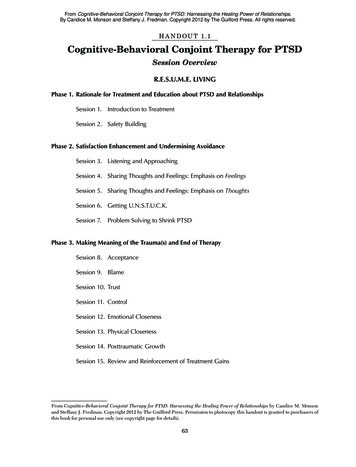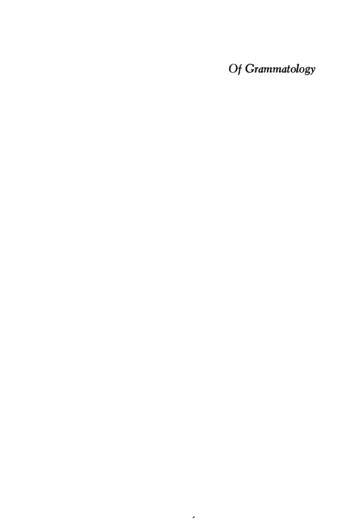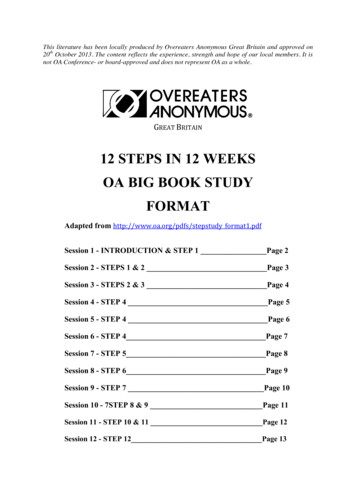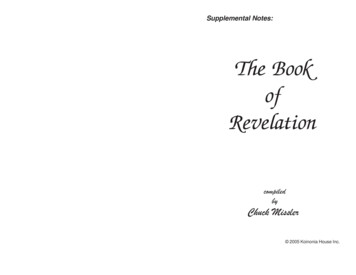
Transcription
Task List 5 ReviewSession 1: Philosophical Underpinnings
is.com was created in the early days of theCOVID-19 lockdown in response to a lack of freely available,layperson resources to understand foundational concepts in ABA.The site (currently still a work in progress) aims to cover the entire 5thEdition Task List, with examples from everyday life, clinical practice,and supervision. Everything on the site was written and reviewed bybehavior analysts.
LearningBehaviorAnalysis.comAll the study resources on the site are free, and always will be. Theoverarching assumptions that went into this project are that our sciencematters because people matter (not the other way around), and that ourfield needs a multitude of voices and perspectives in order to grow in asustainable and ethical direction.
Who are we?Clelia Sigaud, PsyD, BCBA School PsychologistBoard Certified Behavior AnalystCreator of LearningBehaviorAnalysis.comFan of severe behavior interventions,frozen raisins, and all manner of things notunder the dome of the standarddistribution.Patrick Jecmen, MS, BCBA Board Certified Behavior AnalystSpecial EducatorContributor toLearningBehaviorAnalysis.comFan of learning new things, good food, goodmusic, good people, and the Oxford comma.We also have a guest star with us tonight.
HERE’STHE PLAN5th Edition Task List:Philosophical Underpinnings We’ll define each ofthese items, giveexamples, and provideopportunities todemonstrateunderstanding. (Youwon’t have to talk.) A1: Identify the goals of behavior analysis as ascienceA2: Explain the philosophical assumptionsunderlying the science of behavior analysisA3: Describe and explain behavior from theperspective of radical behaviorismA4: Distinguish among behaviorism, EAB, ABA,and professional practice guided by the scienceof behavior analysisA5: Describe and define the dimensions ofapplied behavior analysis
A general observation.(We’re good at those!)You may have noticed (of course you did!)that many of the items we’ll be reviewingtoday aren’t specific to behavior analysis atall. You’re right!Behavior analysis is a science, andtherefore based on foundationalassumptions shared by all branches ofscience.Remember, science is a way of solvingproblems, not a specific subject.www.learningbehavioranalysis.com
When we engage in scientificinquiry, we are accepting a setof assumptions about how theworld works. Without theseshared assumptions, wewould not be able to agree onany resulting findings, and itwould be impossible to build abody of scientific evidence.www.learningbehavioranalysis.com
A1: Identify the goals of behavior analysis as ascience (i.e., description, prediction, control).www.learningbehavioranalysis.com
Goals of Behavior Analysis (& science!)Description: A collection of facts about the observed event(s)that can be quantified, classified and examined for possiblesimilarities to other known facts. (“I know what the behaviorlooks/sounds like.”)Prediction: Repeated observations reveal that observing otherevents can consistently result in accurately anticipating anoutcome. (“I know when the behavior will occur.”)Control: A specific change in one event can be reliably producedby scientific manipulation of another event. This change is notdue to other factors or variables. (“I can turn this behavior onand off like a faucet.”)www.learningbehavioranalysis.com
ExamplesDescriptionPredictionControlA friend calls you up and asks howyour day was. You begin to describeto your friend that you had a terribleday; you spilled your coffee all overyour shirt and you were late towork. You follow up with maybe ifyou had woken up earlier, youwould not have been rushed whichis what led to the spilled coffee.You have provided your friend aquantifiable description of yourterrible morning.You observe your neighborcollect their mail at the end oftheir very long driveway everyafternoon. You also observethat on afternoons that it israining, your neighbor carriesan umbrella over their head.You can predict that eachtime it rains, your neighborwill carry an umbrella whilethey collect their mail.Every morning you wake upand prepare your morningcoffee. You push the “brew”button on your coffee maker,and coffee pours into the pot.In this instance, control of theproduction of coffee is reliablyexerted by pushing the “brew”button and not by any otheraction.www.learningbehavioranalysis.com
A2: Explain the philosophical assumptionsunderlying the science of behavior analysis (e.g.,selectionism, determinism, empiricism,parsimony, pragmatism).www.learningbehavioranalysis.com
DeterminismDefinition: the assumption that the universe has laws, rules,and order such that phenomena occur alongside other eventsand not accidentally; additionally, these events are able to bestudied.Layperson Definition: Events that occur in the universe donot happen “out of the blue.” Instead, they occur in an orderlyand predictable manner.Cooper, J. O., Heron, T. E., & Heward, W. L. (2019). Applied Behavior Analysis (3rdEdition). Hoboken, NJ: Pearson Education.www.learningbehavioranalysis.com
The struggle is realwww.learningbehavioranalysis.com
Determinism exampleDeterminismA direct support professional working with aclient observes them engaging inself-injurious behavior seemingly “out ofnowhere.” The direct support professionaldecides to seek further support from asupervisor, as they do not accept thepossibility that self injury could arise for noreason. The supervisor then designs anassessment process to help determine whatmight be contributing to the self injury.www.learningbehavioranalysis.comAttributing someone’sbehavior to“randomness” withoutany causal factors isnot using the scientificassumption ofdeterminism.
SelectionismSelectionism: all forms of life, from single cell to complex cultures,evolve as a result of selection with respect to function. There arethree main kinds: Phylogenic: natural selection in the evolutionary history of a species.Ontogenic: selection by consequences during the lifetime of an organism.Cultural: the transference of behavior from one individual to anotherwithin a group of individuals often through modeling and imitation.Cooper, J. O., Heron, T. E., & Heward, W. L. (2019). Applied Behavior Analysis (3rdEdition). Hoboken, NJ: Pearson Education.Tryon, W. W. (2002). Expanding the explanatory base of behavior analysis via modern connectionism:Selectionism as a common explanatory core. The Behavior Analyst Today, 3(1), ningbehavioranalysis.com
Selectionism(phylogenic, ontogenic,cultural).Certain behaviors are selected by theenvironment (i.e. they contact reinforcement)and become stronger. Other behaviors are notselected and become less likely or stopoccurring. All life forms naturally andcontinually evolve through their learninghistory and evolutionary development. Thishappens at an individual level, on a specieslevel, and within cultures.?www.learningbehavioranalysis.com
Kinds of selectionismPhylogenicOntogenicCulturalThe natural evolution of aspecies which includesthe inheritance of survivalcharacteristics passeddown from onegeneration to the next.How the environmentchanges one individualover their lifetime.How the environmentchanges the behaviors ofgroups of people, resultingin “cultural norms” generallytransmitted largely throughmodeling and imitation.www.learningbehavioranalysis.com
Selectionism examplesPhylogenicOntogenicCulturalHumans evolved as bipeds(walk on two legs). The vastmajority of humansambulate this way, andprefer walking. Thepreference for walking, andphysical adaptation to it,was shaped by millions ofyears of evolution.An ultra-marathoner maybe able to run withoutstopping for many hours,without any harm to theirhealth. Environmentalvariables related toexercise behaviorsshaped this ability overthe person’s lifetime.Certain culturalenvironments involve lots ofwalking and running in dailylife. These behaviors amongthe people who belong tothe culture were shapedlargely by imitation.www.learningbehavioranalysis.com
EmpiricismDefinition: the practice of objective observation and measurement of thephenomena of interest.Layperson Definition: Objective observation of events in our environment,using information from (and only from) one or more of our five senses.Essentially, empiricism states that knowledge comes from experimentation andexperience (hence the term “empirical” used as a way to describe research orclassify certain questions – an “empirical question” is one which can beanswered using experimentation).Cooper, J. O., Heron, T. E., & Heward, W. L. (2019). Applied Behavior Analysis (3rdEdition). Hoboken, NJ: Pearson Education.www.learningbehavioranalysis.com
A person thinkingempirically is usingobservable evidenceto gain additionalinsight intosomething.But what about usingempiricism to evaluateGoogle search results?www.learningbehavioranalysis.com
Empiricism exampleEmpiricismYou are chatting with a friend, who asksyou what you feel is the most efficientway to burn calories. Whipping out yourbest scientific thinking, you reply, “Thatsounds like an empirical question,because observable evidence can beused to answer it. I wonder what theexisting research says about this.”?www.learningbehavioranalysis.comIf the question had beenslightly different – forexample, “What is yourfavorite way of exercising?” –an answer about youropinion would have beenperfectly acceptable andnot a violate of the principleof empiricism. Opinions arevalid as answers when thequestion was aboutopinions.
ParsimonyDefinition: the requirement that all simple, logical explanations for the phenomenaare ruled out, experimentally or conceptually, before more complex or abstractexplanations are considered.Layperson Definition: Go for the simple explanation. The complex explanation is morelikely to be wrong or just less helpful.Keep in mind that “simple” is relative to the context, and to the explanations that havepreviously been ruled out. A parsimonious answer may be quite sophisticated - but itwas arrived at logically and is the simplest it can be to explain what’s going on.Cooper, J. O., Heron, T. E., & Heward, W. L. (2019). Applied Behavior Analysis (3rdEdition). Hoboken, NJ: Pearson Education.www.learningbehavioranalysis.com
If I see a client bump intosome furniture and think,“Oh no! Maybe she has abrain tumor that’saltering her balance!” Iam not using parsimony.Be lazy for oncewww.learningbehavioranalysis.com
Parsimony exampleParsimonyYou are walking down the hallway at schooland you pass by a friend. You say, “Hello!”The friend continues walking and does notrespond. You assume that the friend did nothear you, since this is the simplestexplanation. (You would be willing to acceptless likely explanations, such as your friendbeing suddenly mad at you, if you hadadditional evidence to suggest this.)?www.learningbehavioranalysis.com
PragmatismDefinition: the philosophical position that the truth value of a statement is a functionof how well the statement promotes effective action.Layperson Definition: Basically, having a pragmatic viewpoint means believing thatwhat matters is what works (whatever that means in a particular context). A personusing pragmatism would be more interested in the outcome of an idea than in itsinherent “rightness.” Something is seen as “right” to the extent that it “works.”“Truth is an effective action.”Cooper, J. O., Heron, T. E., & Heward, W. L. (2019). Applied Behavior Analysis (3rdEdition). Hoboken, NJ: Pearson Education.www.learningbehavioranalysis.com
Why though?www.learningbehavioranalysis.comA person thinkingpragmatically islikely to believe that“to be effective is tobe right.”
Pragmatism examplesPragmatismA practitioner uses an assessmentprocess that informs effective behaviorchange programming for a client. Thepractitioner does not gather informationbeyond what will contribute to designingeffective programming, and she wouldnot consider an assessment process“better” just because more informationwas gathered.?www.learningbehavioranalysis.com
A3: Describe and explain behavior from theperspective of radical behaviorism.www.learningbehavioranalysis.com
Two “behaviorisms” walk into a bar.Radical Behaviorism: a form ofbehaviorism that seeks to findfunctional relations between events,and takes private events intoaccount.Methodological Behaviorism: seekto find functional relations betweenevents, but consider private eventsoutside the realm of scientificaccount.Cooper, J. O., Heron, T. E., & Heward, W. L. (2019). Applied Behavior Analysis (3rdEdition). Hoboken, NJ: Pearson Education.www.learningbehavioranalysis.com
Distinguish!Radical (it’s ALL behavior)Everything we do (observable and not) issubject to the same laws of behavior.Essentially, there is no distinctionbetween stuff we do that others can’tsee/hear (thoughts, such as “there’s noway I’m passing this exam”) and stuff wedo that others can see/hear (walk up aflight of stairs, eat ice cream, pretend tostudy while actually on instagram, l (onlydirectly observable thingsallowed!)We can’t use scientific principles to findout about things we can’t directlyobserve and measure, so they are leftalone in favor of focusing on observablevariables.
Radical vs methodologicalexamplesRadicalA client displays aggression when ritualsare interrupted. A team membersuggests that this behavior is caused byanxious thoughts. As a radicalbehaviorist, you believe that thoughts arebehaviors, and you conceptualize thecase that A client displays aggression when ritualsare interrupted. A team membersuggests that this behavior is caused byanxious thoughts. As a methodologicalbehaviorist, you believe that thoughtscannot be intervened on scientifically,so you focus on a behavior analyticconceptualization of the case based onobservable and measurable dimensions.
A4: Distinguish among behaviorism, theexperimental analysis of behavior, appliedbehavior analysis, and professional practiceguided by the science of behavior analysis.www.learningbehavioranalysis.com
So many terms.Experimental Analysis of Behavior: focuses research on basic processes andprinciples.Applied Behavior Analysis: focuses on applying basic principles to solveproblems of social significance while systematically evaluating the applications.Professional Practice Guided by the Science of Behavior Analysis: focuses onprofessional practice and consultation.School of Behavior Analysis. Florida Tech. ranalysis.com
Can you tell these apart?Applied behavioranalysisExperimentalanalysisRemember the 7dimensions*? They belonghere! 1) Generality, 2) Effective,3) Technological, 4) Applied, 5)Conceptually Systematic, 6)Analytic, 7) BehavioralLook, we can demonstratethat changes in theenvironment are linked tochanges in behavior! Howinherently cool!*Baer, Wolf, Risley, 1968Professionalpractice guidedby B.A.What it sounds like actually providing servicesinformed by behaviorism.www.learningbehavioranalysis.com
Examples!AppliedbehavioranalysisA practitioner uses thescience of behavior tobring about sociallymeaningful outcomesfor alanalysisProfessionalpracticeguided by B.A.Researchers study theeffects of multipleschedules of reinforcementon skill acquisition in rats.A health care providercoaches a caregiver onpraising a patient’scooperative behavior.
A5: Describe and define the dimensions ofapplied behavior analysis (Baer, Wolf, & Risley,1968).www.learningbehavioranalysis.com
The 7 DimensionsApplied: The commitment to supporting improvements in people’s behaviorsto enhance their quality of life.Behavioral: Observable and measurable behavior should be the focus of ourwork.Analytic: The demonstration of a reliable functional relationship betweenenvironmental changes (assessment/intervention) and target behaviorchanges. Most basically, being analytical means making data-drivendecisions.(Seth Meyers uponreading Baer, Wolf,Risley, 1968.)Baer, D. M., Wolf, M. M., & Risley, T. R. (1968). Some current dimensions of applied behavior analysis.Journal of applied behavior analysis, 1(1), 91–97. behavioranalysis.com
The 7 Dimensions cont.Conceptually Systematic: All procedures used in practice should be related tothe basic behavioral principles of behavior analysis from which they werederived.Effective: Behavior that changes in a practical manner that result in clinical orsocial significance.Generality: Behavior change that lasts over time, appears in environmentsother than the environment which it was taught and/or spreads to otherbehaviors not targeted by the intervention.Baer, D. M., Wolf, M. M., & Risley, T. R. (1968). Some current dimensions of applied behavior analysis.Journal of applied behavior analysis, 1(1), 91–97. om
Good luck!We hope today’s overview was useful, and wewish you the best in your studying!For more (free) information on ABA, please goto LearningBehaviorAnalysis.comTo connect with us, pleaseuse the Contact Me page(goes to Clelia) or rjecmen@gmail.com
Task List 5 Review Session 1: Philosophical Underpinnings. LearningBehaviorAnalysis.com LearningBehaviorAnalysis.com was created in the early days of the COVID-19 lockdown in response to a lack of freely available, lay










